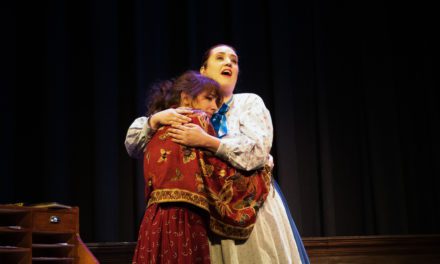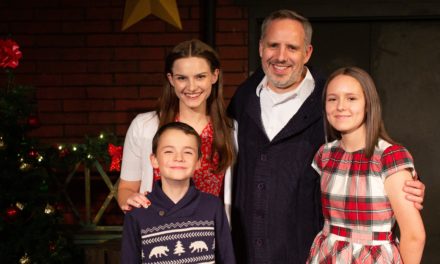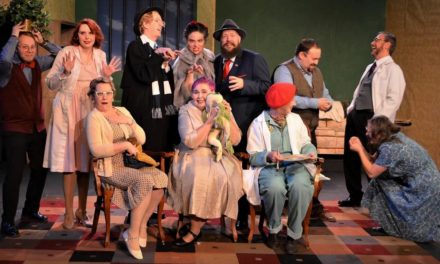OREM — There’s something warming in rediscovering an old love, in remembering things once lost. I recall days spent in my youth, curled up with a mug of hot chocolate, and listening to old-time radio shows like Fathers Knows Best, complete with little advertisement jingles for Ovaltine, and family-centric melodrama. Voice actors with a caricatured charm acted out stories that lulled me off to sleep. These were the quintessentially happy moments of my childhood; the carefree, comforting charm of listening to radio shows eclipsed many alternatives. From the first moment I entered the theater to see You Can’t Take It With You, I was overcome with such a sense of nostalgia. That same warm, happy feeling settled almost immediately: scratchy radio crooners, singing 1930/1940’s standards set the tone for production. And what a warm, charming production it was.
This George F. Kaufman and Moss Hart‘s Pulitzer-winning play focuses primarily on the eccentric Sycamore family, and their high-energy existence. There’s a very strange tone of existence in their house, full of nuanced professions. Family patriarch Grandpa keeps snakes and faithfully refuses to pay income taxes to the IRS. His daughter Penny writes melodramatic plays, while her husband Paul Sycamore devotes his time to crafting bigger and better fireworks with friend (and former ice man) Mr. DePinna. Essie Sycamore-Carmichael devotes her time to (rather bad) ballet dancing, while her husband Ed plays xylophone and helps to sell candies made by his wife. Rheba acts as housekeeper, and her beau Donald take care of odd jobs around the house. The frenetic energy is only tolerated by “normal” daughter, Alice Sycamore, who is very much in love with co-worker and future fiancee Tony Kirby. And though Alice is convinced her unconventional domestic setting might push Tony away, he seems surprisingly welcoming of her family. It is only when Tony’s parents show up for dinner on the wrong night that things go horribly wrong as everyone spends the night in jail on suspect of plot to dynamite Washington.
Director Laurie Harrop-Purser‘s decision to begin the show with a radio program helped to set a proper tone for this production. Period tunes and commercial jingles framed the era well and served as a pleasant diversion between act changes. I appreciated the thought that went into the radio show, and thought the directorial choice to utilize the radio program as framework for the actions of the play provided seamless transitions. The cool, composed format of the show contrasted with the frenetic energy of the Sycamore household. The many eccentric characters on stage all at once was somewhat overwhelming at first, but I was relieved to find the actors made their characters realistic and endearing. What could have been a caricature of a strange family turned into something more believable. I found myself falling in love with the quirky household, engaged in all the nuances and wanting to get to know each individual better.
The core of actors really sold this show for me. Harrop-Purser’s casting showed strength in the UVU Theater Department, and the cohesive energy lent to an honest family feel. Katrina Luthi as Penny Sycamore anchored the family with a sincerely maternal care, perhaps a bit vacant at times, but in an air that fit well with the character. Her kindness, enthusiasm and a genuine love for the members of her family resonated well and never failed to bring a smile to my face. Kacey Spadafora‘s Paul Sycamore was imbued with a similar sincerity. Though a bit spacey and not filling an entirely conventional father’s role, he was loving and devoted all the same.
I was particularly impressed by Jason Evans as Grandpa, whose ability to tether the family’s zaniness state to reality gave a needed counterpoint to the play. His humble acceptance of his circumstances allowed for some truly touching moments.His simple prayers, offered at family mealtime, resonated with an absolute sense of gratitude and love. Of note, too, was Rachel Bigler as Alice Sycamore. The role presents a particularly challenging division of loyalties, both loving of her family and resentful of their strangeness. Bigler navigated the role with a lovely dexterity and sincerity, making the emotional strain easily relatable. And I would be remiss if I did not mention the youthful optimism and elegant charm Alexander Woods brought to his Tony Kirby. His ardent love for Alice, and seemingly simple wish for her to accept his desire to love her, played well amidst the chaos and rapidly moving plot.
Technical elements served to provide strong foundation for the action of the play. Set design (by Tayler Drummer) made excellent use of the space depicting the interior of the family’s house. I was never left without something to look at; interior decoration provided some fun little quirks that accentuated the Sycamore family’s eccentricities and demonstrated Drummer’s thoughtful look into their daily lives that seemed to tell a story of its own. Costumes and makeup (by Estee Parker and Ann Cornell Thomas, respectively) helped to delineate time period well. Again, it was easy to see the individual characters’ stories in the details of their costuming. My only complaint was that some characters’ age makeup (most notably, Penny Sycamore) felt too heavy for the space, but the transgression is a minor one.
All in all, I was entirely impressed at the ability of the cast and crew to make a seemingly chaotic whirlwind into a streamlined, cohesive story. Individual pieces in the production came together with a finessed direction, allowing for a comfortable night of theater. Harrop-Purser successfully played on the notion of simplicity, of gratitude and family, and I found myself wanting to see the show again and again, if only for the satisfying nostalgia it stirred up. The theater became our home for the night, a welcome reprieve from the busy chaos of the world. And what a warm and cozy home that was.






